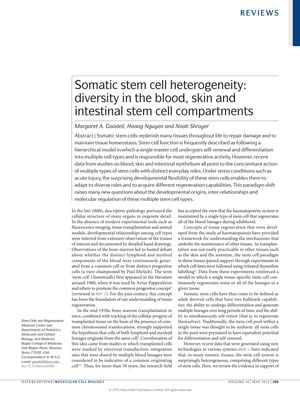Somatic Stem Cell Heterogeneity: Diversity in the Blood, Skin, and Intestinal Stem Cell Compartments
April 2015
in “
Nature Reviews Molecular Cell Biology
”
somatic stem cells hematopoietic stem cells HSCs interfollicular epidermis hair follicles lineage tracing molecular markers microenvironment niche cells intestinal stem cells regenerative medicine progenitor cell types stem cells blood stem cells skin stem cells hair follicle stem cells stem cell markers stem cell niche gut stem cells tissue regeneration

TLDR Different types of stem cells with unique roles exist in blood, skin, and intestines, and this variety is important for tissue repair.
The document from April 23, 2015, examines the complexity and diversity of somatic stem cells in the blood, skin, and intestinal compartments, challenging the traditional view of a hierarchical stem cell structure. It reveals that multiple stem cell types with distinct roles and developmental flexibility exist within these tissues. In the blood, different hematopoietic stem cells (HSCs) are influenced by intrinsic and extrinsic factors, with recent studies suggesting a consortium of stem cells rather than a single multipotent cell type. In the skin, separate stem cell populations maintain the interfollicular epidermis and hair follicles, with lineage tracing experiments identifying various molecular markers that distinguish these populations. The document also discusses the role of the microenvironment in determining stem cell fate, particularly in the hair follicle, where niche cells influence characteristics and behavior. Additionally, it covers the plasticity of intestinal stem cells, with non-stem cells capable of reverting to stem cells during regeneration. The document concludes that understanding the diversity and adaptability of stem cells is crucial for regenerative medicine and that multiple progenitor cell types may be necessary for optimal tissue regeneration.










